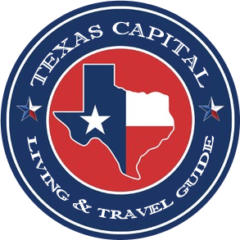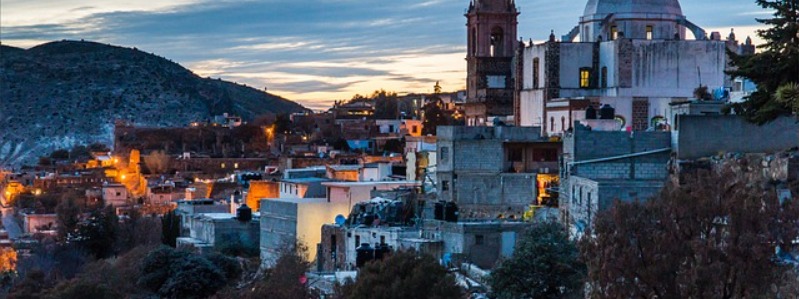Mexico is safer than many cities in the U.S.
Contents
More than 150,000 Americans safely visit Mexico every day. And while the media sensationalizes stories of violence in Mexico, Mexico is safer than many major U.S. cities. Travelers feel relatively safe visiting popular U.S. cities like Miami, Philadelphia, Chicago, New Orleans, Washington D.C, or Atlanta. Visitors from around the world enjoy these vibrant cities in relative, reasonable safety. Yet each of these cities is statistically less safe than Mexico.
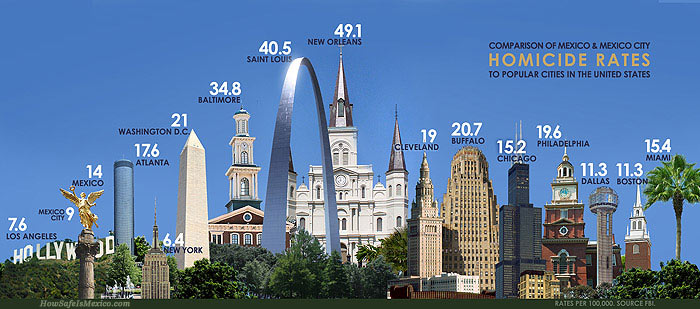
Mexico and politically charged Media Bias.
In the debate on immigration reform in the US, the facts on safety in Mexico have become a casualty of politics. Politicians sometimes throw fuel on the fire to change public opinion and policy. If you make up an exciting story about “severed heads in the desert,” it gets a lot of attention, and people believe it. The governor of Arizona admitted this story was baseless, but only after months of damage was successfully inflicted on the image of Mexico. The homicide rates above are facts from the FBI, not political fabrications.

Media Favoritism versus Facts.
New Orleans is beloved, and its renaissance is showcased in the news. The FBI reports the murder rate in New Orleans is declining, but it is nearly four times higher than all of Mexico and over five times higher than Mexico City. New Orleans is still an amazing place to visit, and the Media is right to champion this inspirational city. But Mexico is at least as remarkable, and there is a clear difference in how each of these storied destinations is portrayed in contemporary news.
Every city and country has places that are safe and dangerous. Mexico is no exception. Dangerous areas should be avoided. And those that are safe should be enjoyed and celebrated.
Mexico City is 4 times safer than Washington D.C.
The U.S. State Department in Washington issues warnings about Mexico, yet Washington D.C. is four times more deadly than Mexico City. Washington’s murder rate has been cut almost in half in the last ten years, but it still averages 24 per 100,000 vs. only 8-9 per 100,000 in Mexico City. How do you suppose the U.S. State Department would feel if the Mexican government posted travel warnings for the U.S. capital? Mexico City is a cultural treasure larger than New York, London, or Paris. It is about the same size as London and Paris combined.
Understanding the size and scope of Mexico.
Mexico is huge, ranking 14th among the world’s 249 countries and spanning over 2,000 miles from end to end. Mexico is a nation of 31 states as diverse as the U.S. To put it in context, Mexico is larger than the 19 U.S. states from Texas to Maine! All those states would be the 15th largest country, right behind Mexico at number 14. In addition to 31 states, Mexico has a Federal District like Washington D.C., which is many times larger and many times safer than Washington D.C.
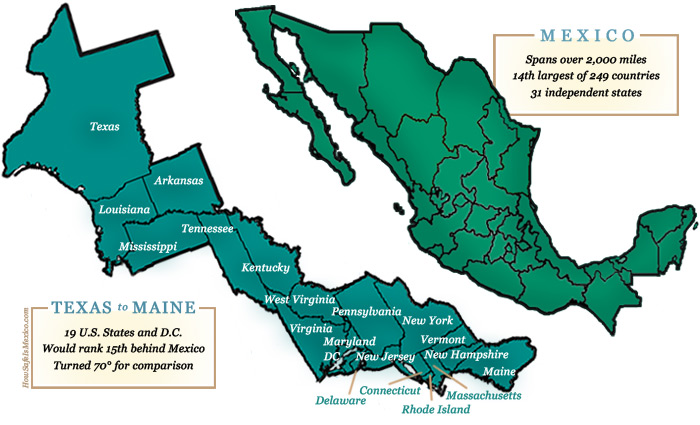
Canceling a vacation to Mexico because of isolated border violence would be like canceling a vacation to Orlando because of the Boston bombing or brush fires in Colorado. These incidents are hundreds, even thousands of miles from the vacation destination. People didn’t cancel trips to Dallas or New Orleans in the aftermath of mass shootings in Arizona, Colorado or Connecticut because they simply aren’t related. Yet Dallas and New Orleans are closer to border violence than many of Mexico’s peaceful tourist areas.
Mexico vs. Other Vacation Destinations
Mexico is safer than many vacation destinations. While the media often portrays Mexico as the most dangerous place on earth, it is statistically quite safe. According to NationMaster.com, which uses U.N.-based data, Mexico doesn’t even make the list of the 25 nations with the highest murder rates. Mild-mannered nations like Sweden and Switzerland top Mexico for murders on NationMaster.com. The assault rate in the U.S. is nearly five times greater than that of Mexico in the independent Prominix report adjusted for under-reported crime.
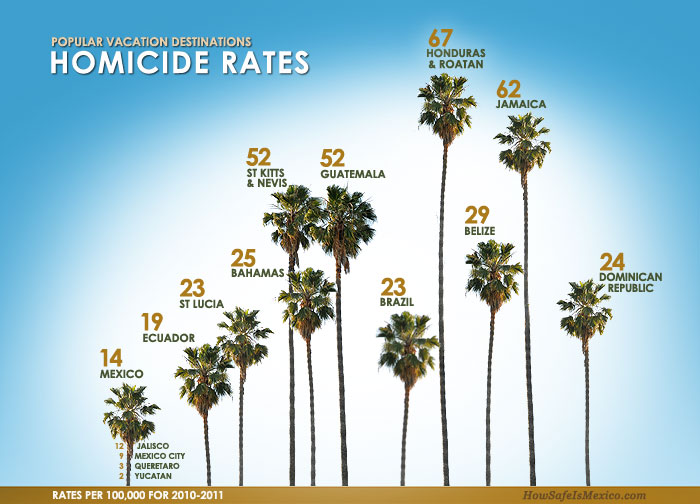
Even when we add on independent estimates for unreported homicides, Mexico ranks 21st behind many popular vacation destinations. Places we think of as idyllic Caribbean retreats have double, triple, or even quadruple the murder rates in Mexico. Mexico’s famous vacation areas are even safer than the average statistics and even safer still for tourists.
Mexico has very low violent crime rates.
The U.S. Assault rate is five times higher than Mexico’s. Mexico’s violent crime rates for Assault, Kidnapping, and Rape are substantially lower than Canada’s, yet the U.S. State Department issues no such warnings for Canada. The rate for Rape in the U.S. is more than double the rate in Mexico. The numbers in the charts below have been adjusted for unreported crime from the respected Prominix report and are the most accurate statistics available on this subject.
Unless you are involved in the drug trade, you are statistically safer in Mexico than anywhere else in North America. Even though the U.S. murder rate of 4 per 100,000 is lower than Mexico’s, tourists and visitors are statistically safer in Mexico and much less likely to be a victim of violent crime than in the U.S., Canada and many other countries regarded as safe.
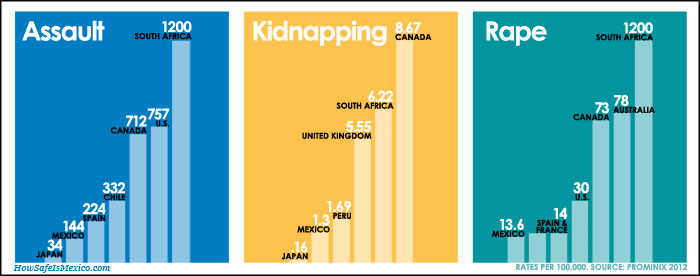
While the infamous cartel crimes in Mexico are disturbing, the rate of violent crimes in Mexico is still lower than the rates in many countries thought of as “safe.”
Which Mexican States & Regions are safe?
The U.S. State Department’s warning recognizes that Mexico’s tourism areas do not experience the safety issues seen along the Texas border. 27 States and the Mexico City Federal District have no advisories or limited advisories outside their tourism areas. Travel to only 4 States is advised to be postponed or avoided.

The Yucatan is as safe as rural U.S. states.
The magnificent beaches and ancient ruins of the Mexican State of Yucatan are among the safest and most spectacular resort beaches in the world. Yucatan’s low homicide rate is lower than the rural U.S. States of Wyoming, Montana, Oregon, North Dakota, West Virginia, and others.

Safe Mexican States with no travel advisories:
- Baja California Sur
- Campeche
- Chiapas
- Estado de Mexico
- Guanajuato
- Hidalgo
- Mexico City DF
- Oaxaca
- Puebla
- Queretaro
- Quintana Roo
- Tabasco
- Tlaxcala
- Yucatan
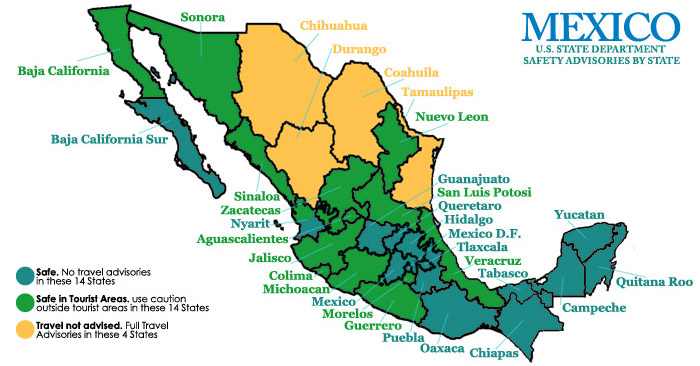
Mexican States where some caution is advised:
These are States where vacationing is enjoyable, but travel outside the tourist areas may place you at higher risk. Cartel violence does not target tourists or tourist areas, but it can be present in other parts of these States, so some caution is advised.
- Aguascalientes Avoid the Zacatecas border.
- Baja California
- Colima Avoid the Michoacán border.
- Guerrero Keep to Acapulco, Zihuatanejo, and Ixtapa.
- Jalisco Guadalajara and Puerto Vallarta are warm, welcoming areas. Avoid the Michoacán and Zacatecas borders.
- Michoacán Keep to Morelia & Lázaro Cardenas.
- Morelos
- Nayarit Limited advisory*.
- Nuevo Leon Keep to the area of Monterrey.
- San Luis Potosi Keep to San Luis Potosi city.
- Sinaloa Keep to tourism areas of Mazatlan.
- Sonora Keep to the area of Puerto Peñasco.
- Veracruz
- Zacatecas Keep to Zacatecas city.
* The entire southern region of Nayarit has no advisories, as shown in the map above. This region extends well beyond the famous Riviera Nayarit resort areas on Banderas Bay. Some caution is advised in the region north of Tepic’s historic capital.
Which States should be avoided by travelers with safety concerns?
The U.S. State Department recommends against travel to 3 states along the Texas border and the state of Durango because of cartel violence. Visitors should exercise extreme caution. While the entire nation of Mexico is showcased as dangerous. These are the States where cartel violence has been focused.
- Colima
- Guerroro
- Michoacan
- Sinaloa
- Tamaulipas
- Zacatecas
It is irresponsible to suggest that every inch of any country or state is completely safe or unsafe. So it is important to note that the violence in the 4 states above seldom targets tourists, making it statistically less likely that tourists will become victims. Yet, the crime rate in those areas is significantly above the national average. Those wishing to avoid the 4 states identified by the U.S. State Department have 28 other states to explore that are statistically safer and at least as beautiful. Travel safely.
Information on this page is based on the advisory on the U.S. State Department website. It is a controversial site worth reviewing as part of a complete snapshot of the safety issues of one of the world’s most fascinating destinations.
Mexico Travel Warning
The U.S. State Department has issued detailed warnings about travel to Mexico. Fortunately, there is a carefully worded prelude that serves as a kind of disclaimer to keep some of the graphic warnings in perspective:
“Millions of U.S. citizens safely visit Mexico each year for study, tourism, and business, including more than 150,000 who cross the border every day. The Mexican government makes a considerable effort to protect U.S. citizens and other visitors to major tourist destinations, and there is no evidence that Transnational Criminal Organizations have targeted U.S. visitors and residents based on their nationality.
Resort areas and tourist destinations in Mexico generally do not see the levels of drug-related violence and crime reported in the border region and in areas along major trafficking routes.”
The travel warning contradicts itself by listing all kinds of frightening crimes and then announcing that a large part of most warning areas (specifically tourism areas) is not part of the advisory described. Some of the content is constructive, but most of what we need to know is in the disclaimer above 1) U.S. visitors are not targets, and 2) Tourism areas are relatively safe.
Dangerous possibilities are presented in graphic detail despite a high level of improbability for any vacationing U.S. national not involved in drug trafficking. There are even warnings about kidnapping, even though the rate of kidnapping is dramatically higher in Canada than in Mexico, and no such warning exists for Canada.
Some constructive comments could apply to travelers anywhere: A logical way to reduce your chances of being victimized is to “lower your profile and avoid displaying any evidence of wealth that might draw attention.” And like everywhere else in the world where there is violence to protect drug interests – including the United States– stay away from areas with drug and gang violence.
The most recent State Department advisory on Mexico is available here:
U.S. State Department Advisory
- For emergencies involving U.S. citizens in Mexico, contact The U.S. Embassy in Mexico City at Paseo de la Reforma 305, Colonia Cuauhtemoc
- Phone from the U.S.: 011-52-55-5080-2000; Within Mexico City: 5080-2000
- Long distance within Mexico 01-55-5080-2000.
- You may also contact the Embassy by e-mail at: [email protected]
- The Embassy’s internet address is https://mx.usembassy.gov/
